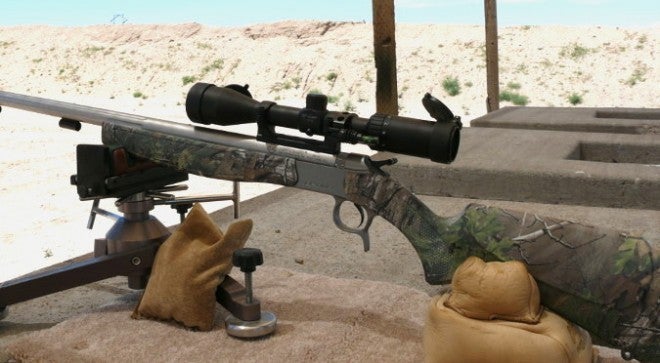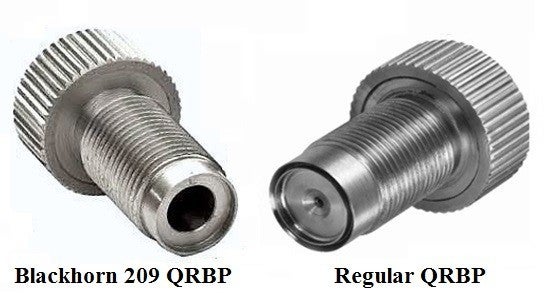This review was written by Dr. Jim and Mary Clary.
The CVA Optima V2 was introduced at the 2013 SHOT Show in Las Vegas. Although it has the same name as previous Optima muzzleloaders and the stock and barrel are essentially the same, the new Optima V2 borrows its action and trigger designs from the “top-of-the-line” Accura V2 series.
The Optima V2 uses the same trigger-guard actuation breeching lever, which is an improvement over the old Optima’s breeching lever located in front of the trigger guard — which looked like the safety on the Ruger Mini 14. The rest of the internal action components are also of the Accura design, with the exception that the trigger weight is not adjustable. In fact, at first look, this gun looks just like the Accura with a one-inch shorter barrel and without the deluxe finish and grip features of the Accura V2 stocks.
The major discernible difference that we could determine was that the Accura V2 models feature a Bergara-branded barrel, while the Optima V2 has a “regular” CVA barrel. For those folks not familiar with the Bergara Barrels, this company supplies high quality center-fire barrels to many of the most respected rifle manufacturers in Europe and the USA. CVA uses these premium quality Bergara Barrels in its top-of-the-line Apex and Accura models. All of the Bergara-branded barrels used in these CVA guns are drilled from 416 stainless steel bar stock and button rifled.
All Bergara Barrels, be they for CVA or other manufacturers, are made in the same manufacturing facility as the standard CVA barrel – as the parent company of CVA also owns the Bergara Barrels plant. The major difference between a Bergara-branded barrel and a “regular” CVA barrel is that the Bergara-branded barrel is put through an additional special 3-step honing process that simulates hand lapping, except that it is more precise. This process removes any deviation in bore diameter. That being said, do not get the idea that the CVA branded barrel is “cheap”. It isn’t! In fact, in our tests, we noticed hardly any difference in accuracy at 100 yards between the two barrels (Accura V2 vs. Optima V2). Having been F-Class target shooters, we will speculate that maybe, just maybe, the Bergara-branded barrel would give a competitive shooter an edge, but for the average hunter, we do not believe that you could ever tell the difference.
Here are the features and specifications for the CVA Optima V2 rifle:
- 416 Stainless Steel, Fluted, 26″ Barrel – .50 caliber with 1:28″ Twist Rifling
- Bullet Guiding Muzzle
- 100% Ambidextrous stock
- Solid Aluminum Palmsaver ramrod (a neat cap that makes field loading easy)
- DuraSight® Integral Scope Mount or DuraSight® Fiber Optic Sights
- QRBP -Quick Release Breech Pug
- Reversible Hammer Spur
- CrushZone® Recoil Pad
- 41″ Overall length
- 6.65 lbs.Total Weight
- 14″ Length of Pull
- Lifetime Warranty
The manual of the Optima refers to the trigger as a “neutral center of gravity” design to provide a light and smooth trigger pull with no creep. I will confess that the term “neutral center of gravity” doesn’t mean much to me, but I will say that this gun had a 2 lb. trigger pull, out of the box, with absolutely no creep. It was absolutely as crisp as any target trigger we have ever used. In this day and age when so many companies are installing “lawyer-triggers” which make it virtually impossible to squeeze off a good shot, CVA gets a “tip of our hat” for this one. In fact, when shooting on the range, one old chap (older than Jim) asked if he could shoot the Optima. Of course, Jim told him “Yes”. After the first shot, he asked if he could shoot it again…. a second shot, then a third…. end of story, after ten rounds he proclaimed that he could shoot competition with that gun. Jim thought he was exaggerating, until he pulled out his customized Anschutz 22LR…. he was still shooting in competitions at 78. That pretty much says it all in regards to the trigger. Oh yea, almost forgot…. once John got the “hang of the gun”, he put four rounds, into the bull at 100 yards for a group measuring 3/4″. Jim can only dream of shooting that well and I can only beat that if I use my 6mmBR. Old John is a shooter!
However, we are getting ahead of ourselves. We mounted a Hi-Lux TB-ML 3-9X40 muzzleloader scope on the Optima. This scope was designed by Toby Bridges specifically for muzzleloaders. It is unique in that it comes with range crossbars below the primary crosshair to provide an accurate point-of-impact for ranges out to 250 yards. Unlike conventional scopes with similar crossbars or mil dots, Toby and the folks at Hi-Lux fired more than 1,000 rounds, using different loads/bullets to compile four ballistic charts included with the scope.
After such extensive tests, we considered it unnecessary to verify the ballistics charts; however, we know that some readers would question our taking them at face value. So, Jim hit the local range and fired over one hundred rounds with the Optima V2 using Blackhorn 209 powder, Alliant Black MZ powder, Hodgdon Triple7 pellets and IMR White Hots pellets. He used the 260 grain Harvester
Scorpion PT Gold with Crush Rib sabots and 250 grain “Powerbelt” Aerolite bullets. Our results confirmed the accuracy and validity of the charts. The main chart that we used is reprinted below. It is for hunters using three of the most popular spitzer or spire point bullets with sabots, as well as CVA’s Aerolite bullet. Our range test confirmations have been inserted for reference. You will want to verify the crossbar distances for your gun on the range before heading out to hunt, as your velocities may be more or less due to the working bore of your gun.
All that remains is for us to determine is the inherent accuracy of the Optima V2 at 100 yards with the four propellants above. Muzzle velocities are provided for performance comparisons between the propellants. However, bear in mind that we are shooting at an elevation of 5,232′ above sea level. The results of those tests for 3-shot groups are as follows (we fired five 3-shot groups with each powder/bullet combination):
100 grains of Blackhorn 209 Powder
Powerbelt AeroLite 250 grain: Average group size = 1.00″ (Mean M.V. = 2,015 f.p.s.)
Harvester 260 grain Scorpion PT Gold: Average group size = 1.00″ (Mean M.V. = 1,965 f.p.s.)
100 grains of Alliant Black MZ
Powerbelt AeroLite 250 grain: Average group size = 1.30” (Mean M.V. = 1,880 f.p.s.)
Harvester 260 grain Scorpion PT Gold: Average group size = 1.25” (Mean M.V. = 1,845 f.p.s.)
2 IMR White Hots 50 Grain Pellets
Powerbelt AeroLite 250 grain: Average group size = 1.13″ (Mean M.V. = 1,800 f.p.s.)
Harvester 260 grain Scorpion PT Gold: Average group size = 1.18″ (Mean M.V. = 1,770 f.p.s.)
2 Hodgden Triple7 50 Grain Pellets
Powerbelt AeroLite 250 grain: Average group size = 1.38” (Mean M.V. = 1,725 f.p.s.)
Harvester 260 grain Scorpion PT Gold: Average group size = 1.25” (Mean M.V. = 1,700 f.p.s.)
All four propellants performed well with both the Aerolite and Scorpion bullets. For the average muzzleloader hunter, the accuracy difference between them is negligible.
The redesigned Optima V2 is an excellent shooter, regardless of the propellant you use. It is more than adequate for just about any hunting situation. Although we only ran our tests with 100 grain equivalent loads, in our discussions with the director of technical support at CVA, he told me that he has shot three pellet loads with no problems, although the recoil was tough. In talking with the folks at Western and Alliant, they have used loads up to 110 grains with good results. However, once again, the recoil increases. Our feeling is that unless you are going for big bear, bison or moose, 100 grain loads are more than adequate.
Your muzzle velocities will vary depending on the condition of your barrel, the working bore of your gun and environmental conditions. The above values were taken from our Chrony and are posted to give the reader an idea of the approximate velocities to expect. However, as with any inline muzzleloader, you are throwing a heavy projectile downrange and as long as the velocity is sufficient to produce enough energy to take down your game.. your primary concern should be accuracy and bullet placement, rather than the velocity.
Some shooters have reported problems using Blackhorn 209 with the regular QRBP, so CVA, in cooperation with Western Powders, designed as an aftermarket item, a Blackhorn 209 breechplug for their entire line of rifles. We fired more than 120 rounds with it and did not experience any misfires or fizzles. As such, if you prefer shooting Blackhorn 209 powder, we recommend that you definitely order the Blackhorn 209 QRBP with your gun. It has an MSRP of $20.95.
With an MSRP of $391 ($317 for standard blued barrel with black stock), this gun should find a comfortable niche in the muzzleloading market – and, as with all guns, you are likely to find them being sold at 10% to 20% below the MSRP at your local dealer. It is well made, comfortable to shoot and handles well. And, it is hard to beat a lifetime guarantee. Jim is keeping this one and intends to use it on his fall mule deer hunt here in New Mexico.
We would like to thank the folks at Alliant, Hodgdon and Western Powders for generously providing us with enough powder to perform all of our tests. And, we are also very appreciative of the folks at B.P.I. and Harvester for providing us with CVA Aerolite and Harvester Scorpion PT Gold bullets. Without the generosity of these companies, it is doubtful that we would have been able to conduct the preceding tests.
 Your Privacy Choices
Your Privacy Choices



